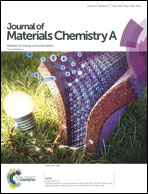Oriented attachment growth of hundred-nanometer-size LaTaON2 single crystals in molten salts for enhanced photoelectrochemical water splitting†
Abstract
Oriented attachment (OA) has been widely used as a term to describe solution-based particle (generally, <10 nm in size) growth proceeding by crystallographic alignment. A big challenge in large-sized crystal growth by the OA crystallization process is the removal of the additives that cause the OA assembling process to occur. Here, we find that the molten salt environment is an ideal medium for OA growth of large-sized inorganic particles without the requirement of any additives. As an example, in Li ion-based molten salts, hundred-nanometer-size LaTaON2 single crystals with no specific morphology can spontaneously assemble into micrometer-size regular crystals. Theoretical and experimental evidence indicated that this OA growth process among the large-sized crystals is governed by a trade-off between electrostatic repulsion and van der Waals attraction, which can be adjusted by the adsorption difference of positive and negative ions on the crystal surface. Finally, due to the significant decrease in charge recombination at grain boundaries, the large single crystal electrode exhibited an enhanced photoelectrochemical performance of 5.1 mA cm−2 at 1.23VRHE, the highest performance among the previously reported LaTaON2 photoanodes. Our findings offer a new approach to assemble large-size single crystals for advanced nanodevices.



 Please wait while we load your content...
Please wait while we load your content...